By Ann Bush
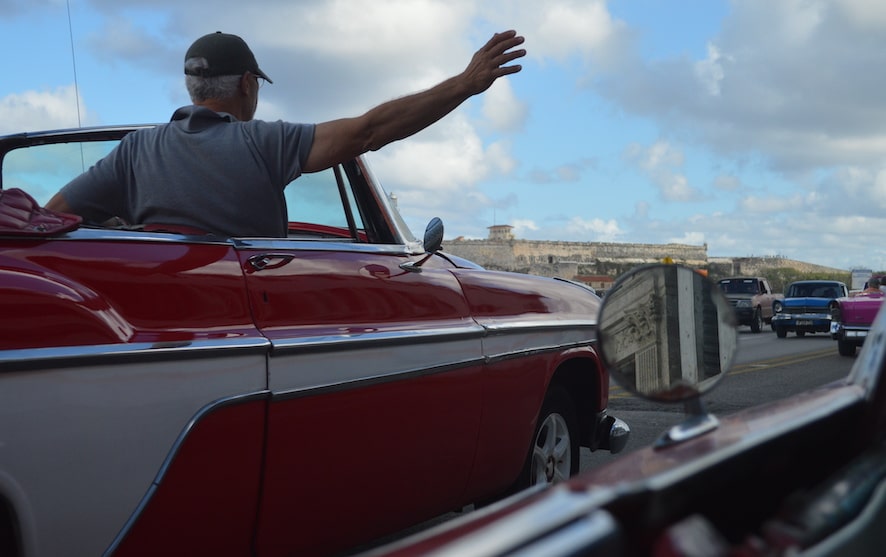
Sixty-year-old sedans are maintained in mint condition by their owners who pass them down from one generation to the next.
Havana was just what I expected.
A city blended with images of vintage cars, cigar-smoking women, a flood of rum, vibrant art and jazz swaying crowds on every Spanish colonial corner. All appeared in turn as I wandered through the old Spanish colonial capital on sidewalks worn thin by tourists’ feet.
During the brief interregnum when Pres. Barack Obama opened the borders for Cuban travel, I joined an organization that performs surveys on the avian migration paths between the U.S. and Cuba. The Caribbean Conservation Trust, a non-profit foundation based in Connecticut, has studied Cuba’s conservation of native habitat and migratory birds for over thirty years.
Many of the bird species that breed and flourish during the summer along the eastern shores of North America winter in Cuba. For this reason, the CCT has Washington’s permission to work with Cuban ornithologists and biologists. This trip’s mission was to track, monitor and document birds migrating from the coast of Maine to various parts of Cuba.
More concerned with the natural environment, we spent little time in Havana. While there I found thousands of European and Asian tourists parading along the avenidas and calles. They were in restaurants after getting off a gigantic cruise ship; in the mountains spelunking caves; deep sea diving in the best preserved coral reefs in the world; sunbathing on long sandy beaches in front of elaborate resort hotels and working as exchange botanists in a botanical garden with over 200 species of cactus. Cuba may be the world’s best kept secret, but only from U.S. citizens.
Growing up during the Kennedy years, the fear of Cuba was firmly instilled. It was my love for birds, and badly wanting to see the Bee Hummingbird, the smallest hummingbird in the world that is only found in Cuba, that pushed the fear aside. What I learned is that Cubans distrust people from the United States just as much we distrust them, however not for the same reasons.
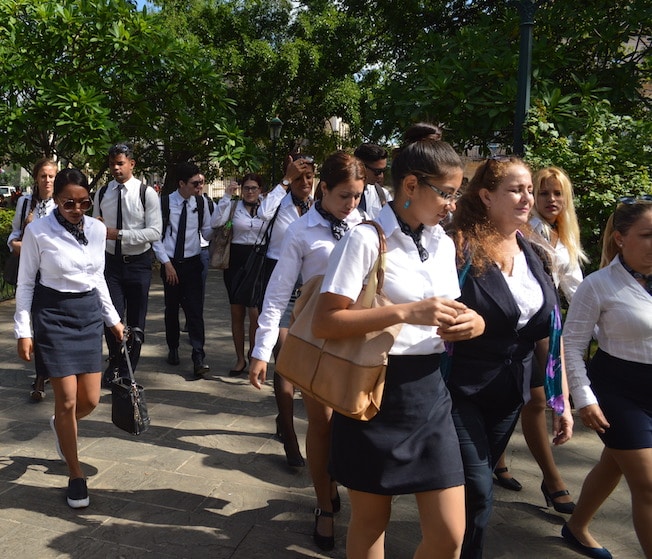
Want to prosper economically in Cuba? Then go into the hospitality industry like these students in Havana seeking tourism jobs.
Before I left the U.S, I watched a documentary about how the American Mafia grew exponentially throughout the early 20th century and eventually found its way to Cuba. They turned Havana into an American gambling haven in the 1950s by bribing the Fulgencio Batista government and building a casino infrastructure to rival Monte Carlo’s. Unfortunately, most of the profits earned from elaborate casinos and hotels went back to the United States, leaving most of Cuba impoverished.
Castro came to power following a guerilla war waged to topple Batista and kick out the U.S. mafia. As Castro neared victory, US citizens fled his wrath, but not before emptying their local bank accounts – leaving Cuba with an empty treasury and hundreds of used sedans. Soon afterward, the Mob shifted its assets to Nevada, where syndicate bosses like Meyer Lansky and Moe Dalitz began transforming Las Vegas into a new Havana.
Our day in Havana included all the normal tourist destinations – a ride in a vintage American manufactured car and dining in Old Havana on Cuban cuisine – a blend of rice, black beans, meat and fish flavored with African, Spanish and Caribbean spices
After lunch we strolled La Habana Vieja in the heart of Cuba’s capital city. The well-preserved Spanish Colonial plaza is surrounded by historic buildings in pastel colors that contain churches, museums, shops and cafes. Vendors found shade under the wide verandas selling cold drinks from small carts full of bananas, mangos and pineapples.
Just a few steps away from the heavily photographed Cathedral de San Cristóbal is La Bodeguita del Medio, a club made famous by Ernest Hemmingway, who frequented the bar to drink mojitos with the locals. Following the custom of thousands of tourists before us, we signed the club’s exterior wall
The next four days of this ten-day trip were spent centered on the western half of the island, exploring a Cuba that international tourists rarely see. Soon, the real Cuba appeared, and I learned more than just facts and figures about their amazing, colorful birds.
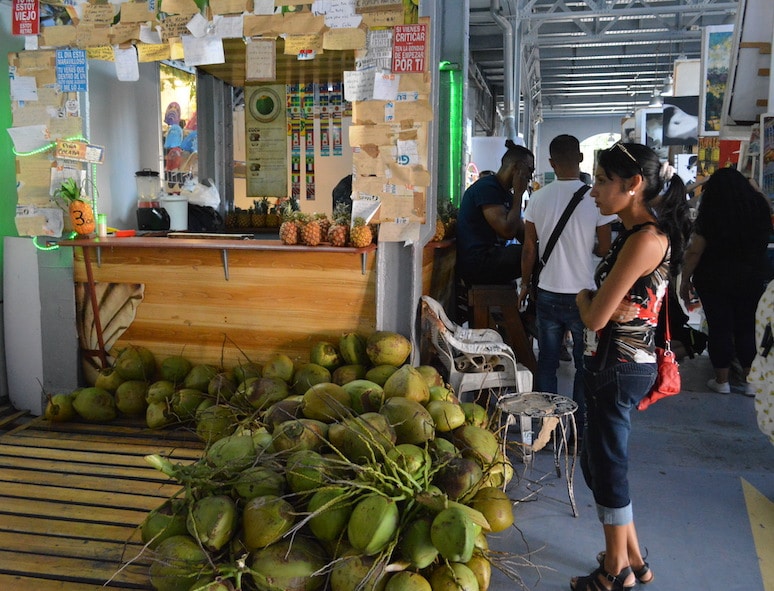
Cuban markets lack many products, but there are plenty of coconuts and pineapples.
The Natural Side of Cuba
Our first destination was the Cordillera de Guaniguanico Mountains bordering the Archipelago de los Colorados on the Gulf of Mexico. We got there on a bus that twisted through narrow streets, slowly leaving behind the pollution and continuous music wafting from homes as colorful as the melodies they emit. Following Highway A4 out of Havana, it did not take long for a very different image of Cuba to emerge.
What is wonderful about bird watching is that you follow the birds and birds have no boundaries. In the process, you explore the natural side of a place, often on private land seldom seen by foreigners Our bus veered off the main freeway, deep into farmland irrigated by rivers streaming from mountain tops.
The countryside rolled past the window in vivid shades of green and newly plowed brown dirt. Stately Royal Palm trees mingle with emerald fields of tall grass being devoured by healthy cattle.
We were almost the only mechanical vehicle on the road, out numbered by horses and buggies. Gasoline is scarce and expensive to import, forcing the rural population to rely on horses for their main transportation. Without gasoline, farmers cannot operate tractors. Sugar and tobacco are difficult to plant without tractors. The limited number of trucks make it difficult to get crops to market. Despite these impediments, Cubans utilize ancestral skills to get their crops to market.
Dirt paths created especially for horses and buggies stretch out alongside the main highway, ensuring safety, and kindness towards hoofs. Some buggies are structured as simple farming equipment carrying hay, milk or sugar cane. Others are colorfully decorated for transporting customers from one village to another. Yellow road signs painted with a little horse and buggy often appear below normal traffic signs at crossroads. Every horse along our journey pulling a buggy or feeding in a field appeared robust and healthy.
Las Terrazas Biosphere Reserve
Less than 80 kilometers from Havana is the Las Terrazas Biosphere Reserve, known for orchid gardens, waterfalls, and the ruins of an 18th-century French coffee plantation. Granted UNESCO status in 1985, the community is thriving today because of international programs to increase biodiversity.
More than twenty years before the UNESCO designation, this area was bare because its trees had been logged for making charcoal. Once the forest was gone, people were left without an income. Located on the Sierra del Rosario peak, the area once was rich in flora and fauna. Its lakes, rivers and waterfalls attracted French settlers to plant coffee following the 1791 Haitian Revolution.
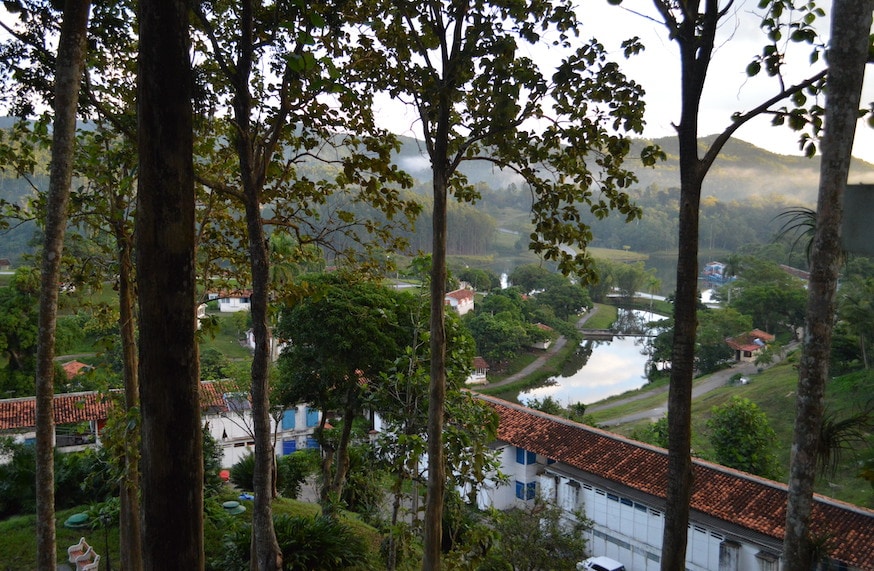
Located at the pinnacle of the Las Terrazas Biosphere Reserve, the Hotel Moka offers relaxing views of land once cultivated by French coffee planters. More than eight million trees planted with help from UNESCO have made the area into a self-sustaining ecological community.
In 1968, as part of Fidel Castro’s Green Revolution Initiative, a group of Cubans and environmental specialists from around the world, sponsored by the UNESCO Man and the Biosphere (MAB) program, obtained approval to create a self-sufficient ecological community. The mission of MAB was to provide a platform for cooperation on research and networking to share information on biodiversity loss, climate change and sustainable development.
They planted over eight million trees on the deforested area by building terraces to avoid erosion; hence the Spanish name of terrazas which means terraces. Many were planted on old terraces located on nearly 70 former French coffee plantations. Creating an oasis of life even better than before, the diverse biosphere draws individuals from all corners of the planet to study or simply enjoy the flourishing forest and wildlife.
The successful project is home to 117 bird species, twelve of which are endemic to this location. While scanning the tree tops I spotted a Cuban Pygmy owl, one of the few that hunts during the daytime. Later, I saw the Cuban Emerald hummingbird. But its shimmering green raiment paled in comparison to the black wings and cherry red legs of a group of Red-legged Honeycreepers dining at a plum tree. Just as dusk set in a Bare-legged Owl popped out of a tree. True to its name, this small brown owl with white spots had no feathers on its legs.
A pleasant contrast from congested Havana, Las Terrazas is where locals go for peace, tranquility and a lot of shopping. The eco-village of Artemisa is now a haven for artists with vegetarian cafes, coffee houses and shops full of art, textiles and wood crafts plus colognes from local flowers. The artisan community enjoys charming homes, schools and medical services for almost a thousand permanent residents.
In Artemisa is El Romero, a popular café considered to be the best vegetarian restaurant in Cuba. Nearby is the studio of well-known Cuban artist Ariel, who paints watercolors of local birds and flowers on recycled paper. Picnicking, kayaking and bungee jumping are popular activities. More information can be found concerning day tours from Havana and lodging availability at Las Terrazas Resort.
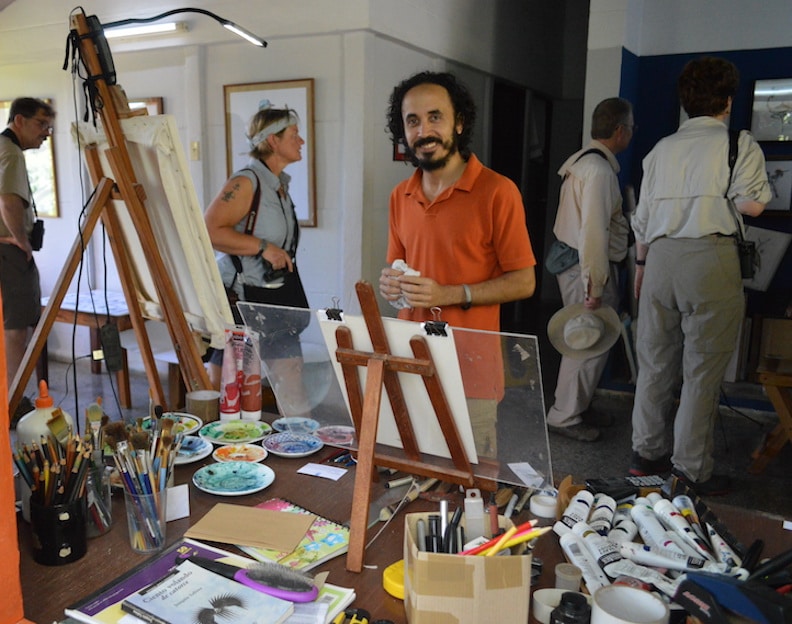
Cuban artist Ariel sells most of his watercolors to foreign tourists passing through Las Terrazas.
Hotel Moka, the largest lodging accommodation, is booked solid most weekends. Located on the reserve’s highest point, the white-washed lodge is almost hidden under a forest canopy with spectacular views of the busy village and lake from an open-air lobby. Terraced balconies with comfortable chairs and hammocks follow the natural flow of the mountain, with people strolling in and out of cafes and patios cascading down a hillside covered with flowers and fruit trees. An open-air jazz club starts swinging at sunset.
Also a short drive from the biosphere are the ruins of an 18th-century French coffee plantation that has a restaurant with panoramic views.
Tobacco Plantation Territory
A few days later, we entered the tobacco country of Vinales Valley. It was the November planting season and the bright green tobacco shoots were only a few inches high. Fields with orange-hued dirt and perfectly straight rows of newly planted tobacco give this valley a unique character. Tobacco traditions and culture have changed little over the centuries. Few tractors are used because of the petroleum shortage, but oxen, horses and hand plows seem to get the job done.
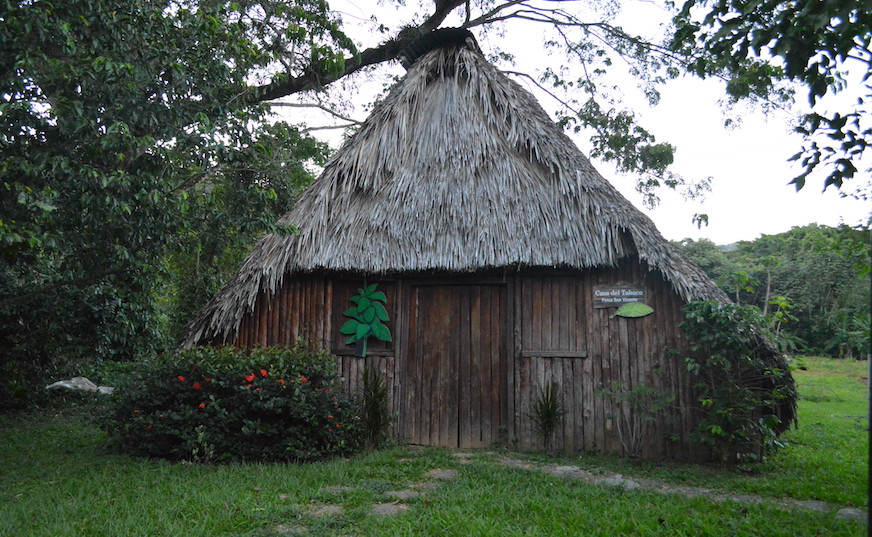
Tobacco shed in the Vinales Valley
Taking a dirt road through a complex of fields to an old tobacco barn and unadorned farmhouse, we stop for lunch and meet Rosita. Her family kitchen serves a patio restaurant. It is one of the most popular gathering spots in the Vinales Valley. Enormous tables the length of a tourist bus are sheltered from the Caribbean sun by a canopy of palm fronds. People from tour buses fill a hundred or more chairs and happily chat in numerous languages. Cuba’s borders are open, just not to the United States.
Lunch at the Rosita Restaurant was much like most meals we encountered during this trip – grilled chicken, pork or beef, a raw vegetable salad, fluffy white rice and black beans – all served home style with never ending plates of food finding our table. Meals always ended with Cuban espresso served with a sweet dessert, usually creamy rice pudding.
As we dined and discussed birds, Rosita joined us and answered our many questions about rural life in Cuba. She told us of her multi-generational family’s history and their love of Cuba, but coyly refused to give us her black bean recipe.
Valle de Vinales National Park
Continuing west we proceeded to the Vinales Mountains, known for steep limestone mogotes and spacious caves. Drawing spelunkers from around the world, the Santo Tomas Cave System is one of the largest in Latin America, consisting of seven levels that string 47 kilometers of interconnected caves and galleries. Pre-Columbian rock art appears throughout the caves along with very large galleries encrusted with stalactite and stalagmite formations.
The Cueva del Indio cave is eight kilometers from the village of Vinales and is unique because half of the journey into the cave is by boat. The San Vicente River flows through the cave with pictographs and drawings hovering overhead. Tours and cave excursions are sold in the village of Vinales.
The Palenque de los Cimarrones cave is seven kilometers from the village of Vinales. Smaller than most of the caves, the Cimarrones has a short trail perfect for inexperienced spelunkers.
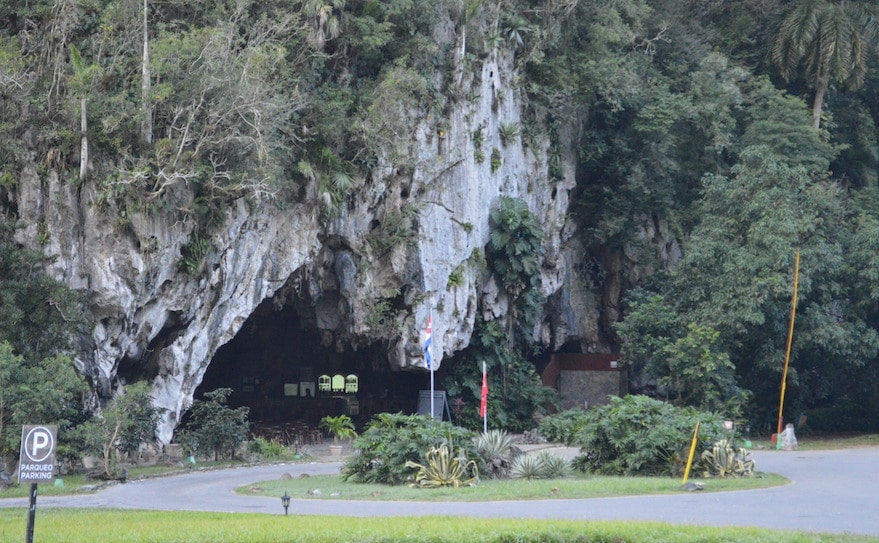
One of the many entrances to caves in the Valle de Vinales National Park
The cliffs forming Vinales Valley are designated a Natural Heritage of Humanity site by UNESCO because they protect a place where traditions are rooted in peasant culture. The valley is little touched by civilization, leaving an endemic natural environment that is home to the Cuban Todys, a small bird resembling a dwarfed parrot that is emerald green with a rose patch at the throat and soft sky blue feathers underlining coal black eyes. The valley also is full of water birds, warblers, crows and sparrows visiting from North and South America.
The village of Vinales sits at the foot of the surrounding cliffs and has a charming assortment of small homes serving as bed & breakfasts. In 2004, Raul Castro passed a law allowing Cubans to own their own homes. In this busy tourist area, many are now used as hostels decorated with bright colors and elaborate iron fences. The B-and-Bs are registered and inspected by a special government hospitality department and can be booked with Trip Advisor.
Lessons Learned
After four days of traveling through rural Cuba I’m left with the impression that, despite his faults, Fidel Castro is beloved for his accomplishments. The U.S. trade embargo is a source of concern since it negatively impacts the economy and separates Cubans from relatives living in Florida. Ongoing domestic corruption is a constant irritation since it diverts profits that should be used to build more schools and hospitals.
Cuba is a small island with limited resources. Many of its people are poor according to the U.S. poverty scale. But they are enriched by living in a country blessed with natural beauty and old-world history.
Ann Bush is a writer specializing in the natural beauty of our planet, unique historic sites and birding.

